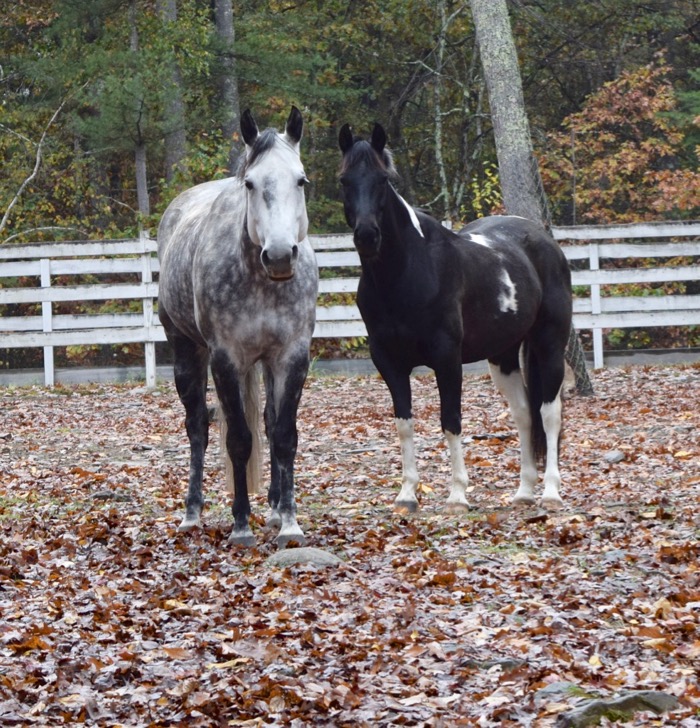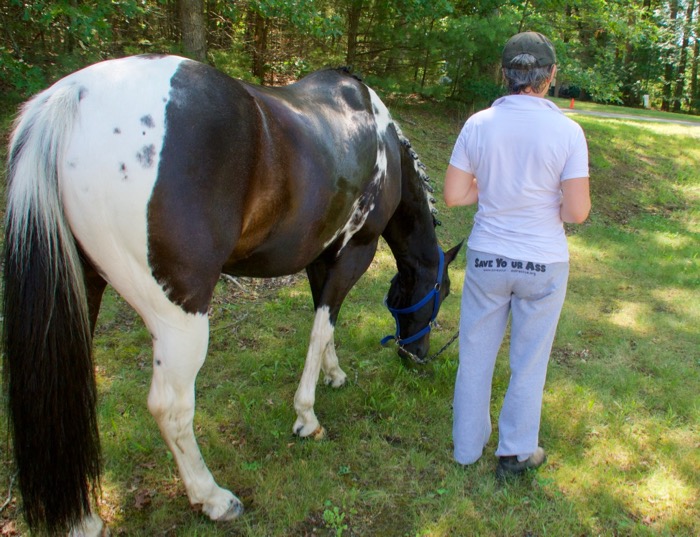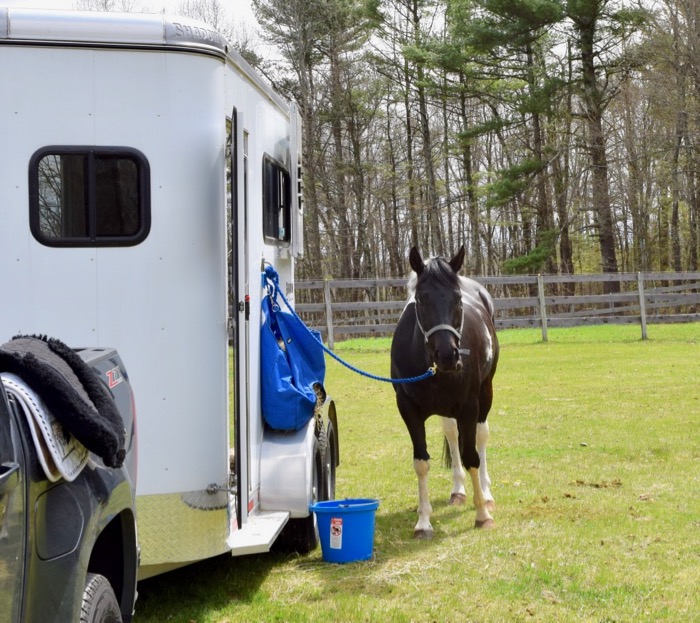Yesterday I trailered Tonka to meet up with his friend Maggie. Tonka hadn’t seen Maggie for a year, but before that they’d been stabled next to each other and had been paddock-mates.

As it’s said time and again, horses are herd animals, so Tonka was bound to be pleased to see another horse when we arrived. But it’s more complicated than that. They don’t simply want to be with other horses, they care deeply about who they’re with. Within the group, individuals bond closely with one or two others. These are lifelong friendships. Horses never forget the ones they love. Which sounds (and is) sweet, but causes issues for their humans.
A horse, reunited with a long-lost friend, might do any number of things. If you’re in a situation in which your horse has to be restrained, instead of being able to freely greet his friend, for example at a horse show, your horse might neigh loudly, or try to barge through whatever now separates them, or become uncontrollably hyper. Under saddle, the horse might buck, bolt, rear or jig, which is dangerous for both horse and rider. We can control our horses with severe bits, other gear, and rough handling, to keep us safe in the moment, but our mounts will remain tense. Repeat this scenario of punishing their emotional state each time that you put them in this sort of situation, and you’ll have a horse that is anxious whenever you go out.
This behavior can become more intense when you arrive at a show and your horse sees a friend. Here is a video of Tonka, taken three years ago, at our second show. He’d seen Maggie in the parking lot, and then in the schooling ring. But when we rode down the centerline to do our test, Maggie was out of sight. (Make sure that you have your volume up for this!)
Notice that I’m smiling. Not much to do about that body-shaking neighing at the moment! Also note that quick halt. I knew that if I tried to make Tonka stand still that there’d be some bouncing. This wasn’t the time to fix things. In any event, it was a novice test, Tonka won the class and we got a high point award! If I’d fussed and tried to suppress his behavior, I’m sure we wouldn’t have ribboned.
In the three years since then, I’ve thoughtfully addressed this sort of situation. It all starts well before you enter the ring. Here’s some of what I’ve done:
Become your horse’s friend. Through grooming, hand-grazing, quiet time, being a calm anchor in a scary place, etc, you can be as important to your horse as their four-legged friends.

Train that good things come through you. Access to what your horse wants should always come after the horse shows self-control and focuses on you. This is for every behavior. Be aware of them! For examples, I teach a permission to “graze” and when turned out in his pasture, Tonka has to stand quietly while I take off the halter. Be consistent about this, and the horse will politely ask you for what they want. So, when he sees a long-lost friend, he turns to you to get access to them.
Train for flexibility. Go on trail rides, to shows, to other barns. Ride alone. Ride with friends. The more you do, the more you can do. But the caveat is that you might need to start small. Can you ride in the outside ring when everyone else in indoors? If not, can you hand-graze outside when everyone else is in? Your horse will determine how challenging the scenarios can be.
Create rewarding behavior chains. For example, tying to the trailer is a basic necessity, but there was much training before I was able to do this:

Tonka first had to learn to tie at home, in the barn aisle, then to the trailer, then to the trailer away from home. He had to learn to stand with slack in the rope, to move his body over when I asked, and to stand still when I unclipped the lead line. I made all of these steps rewarding, but continually increased criteria. I don’t reward for the exact behavior, over and over. I’m always increasing something, such as duration, position and demeanor. Also, once the behavior is established, I link it to another. This is called a behavior chain. The last behavior of that chain is rewarded. So for a usual outing, Tonka backs calmly out of the trailer, gets tied to it, then is tacked up, and then is mounted. He gets his reward of one peppermint once I’m in the saddle. Each of these steps were reinforced when he was first introduced to them, and then added to the chain. They no longer need to be rewarded individually. But there’s always a reward at the end of the chain.
Fix things before they break. Be alert to weaknesses in that chain and go back and strengthen the links when necessary.
Yesterday, I parked next to Maggie’s trailer.

Tonka hollered a hello, and then was quiet.

After unloading, Tonka calmly stood tied to the trailer, but when I brought the saddle over, Maggie went out of sight (to her side of the trailer to be tacked up) and Tonka tensed. His head went up and I saw muscles quiver. The behavior chain was about to break. Before that aroused body language had a chance to escalate, I pat him, which caused Tonka to refocus and look at me, which gave me a still and calm second, which I rewarded with a good boy! and a sugar cube. That’s all it took for him to settle and resume the calm behaviors that make up that chain.
Manage the situation. All of this work helps to create horses that can have their friends, and still be ridden in challenging situations. But sometimes managing the environment is the best solution. It’s easier to go to shows where your horse doesn’t have a close friend that causes separation anxiety. If going solo isn’t possible, keep the sight-lines open so that the horses know where each other are and where they’re going. A sudden separation is more upsetting to a horse than watching a friend walk away from them to the ring.
Change your expectations. Michele and I have worked with our horses so that we can ride away from each other on the trails. But we haven’t done this training for over a year and I didn’t expect to be able to pick up where we left off. As much as I wanted to do some canter work, on our ride yesterday, it was of utmost importance not to strain Maggie’s tendons. She’s recovering from an injury and had to walk. And so we ambled near each other and didn’t ask the horses to separate.

After the ride, we untacked at our separate trailers, and the horses peacefully said their good-byes. Tonka didn’t holler, but I’m sure there was communication in a way that I am too dull to perceive.

Tonka arrived back at his home barn calm and relaxed. He said hello to Lu, the horse in the stall next to him, and then settled in for his evening meal. What seems like basic, everyday behavior is actually quite complicated. This one little excursion required Tonka to have mental flexibility to function in different social groups, be comfortable in varied surroundings, and to trust me. It makes me happy to see it.



This is really good education about interpersonal relationships AND training!
Thank you!
Adorable whinnying!! Can we see the whole test?
Heading off to CCI* at Bromont in two weeks…wish us luck.
Oh that is so exciting! Good-luck! Have fun!
Interesting post. I like your talk about building the behavior chain.
Great post! Interesting about the behaviour chain. Taking my pony off the property is a bit of a hang up of mine so this is really helpful 🙂
People assume that riding off property is simply something that comes with having a horse, and yet I think it’s one of the most fraught with difficulties! Let me know how you do!